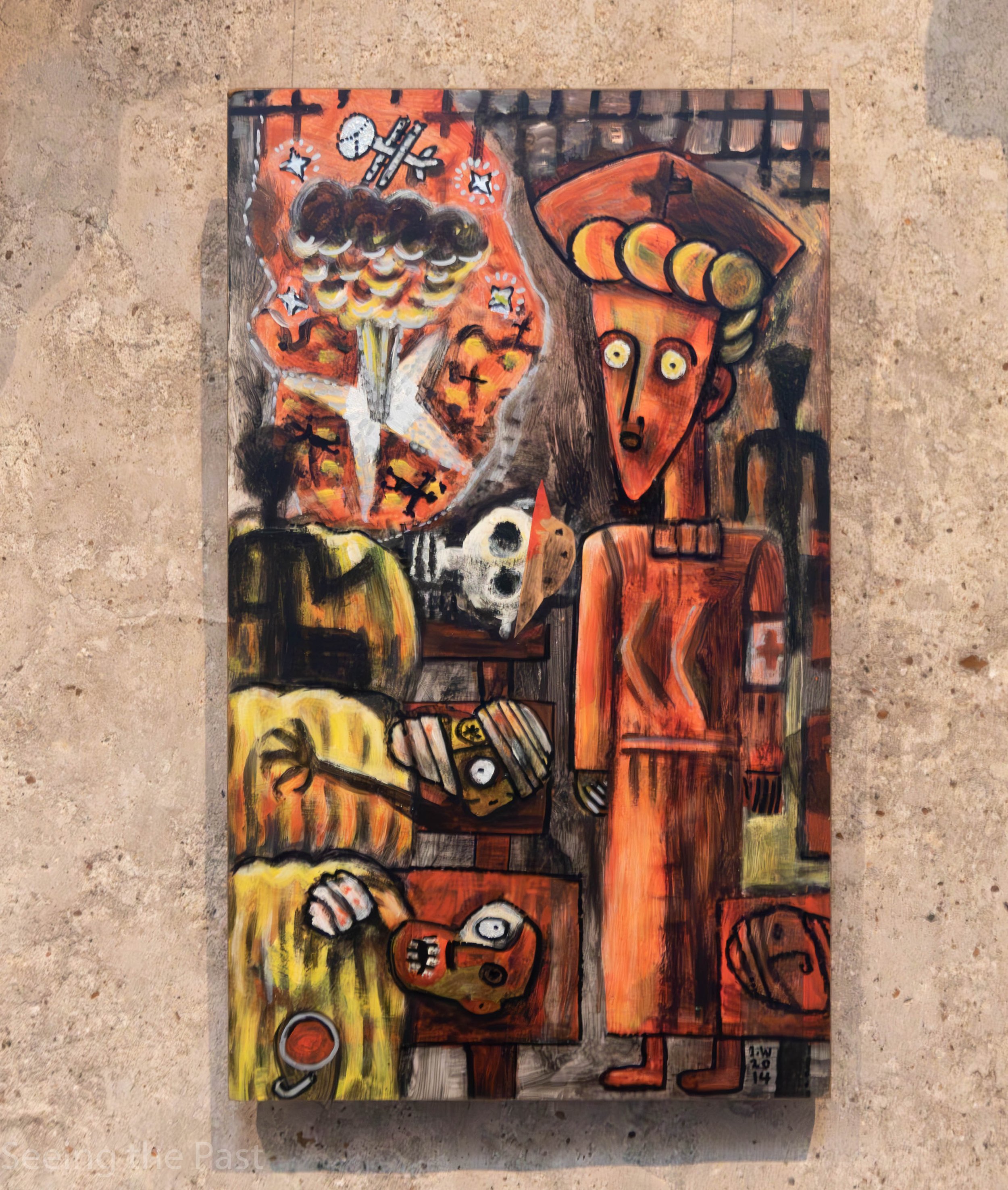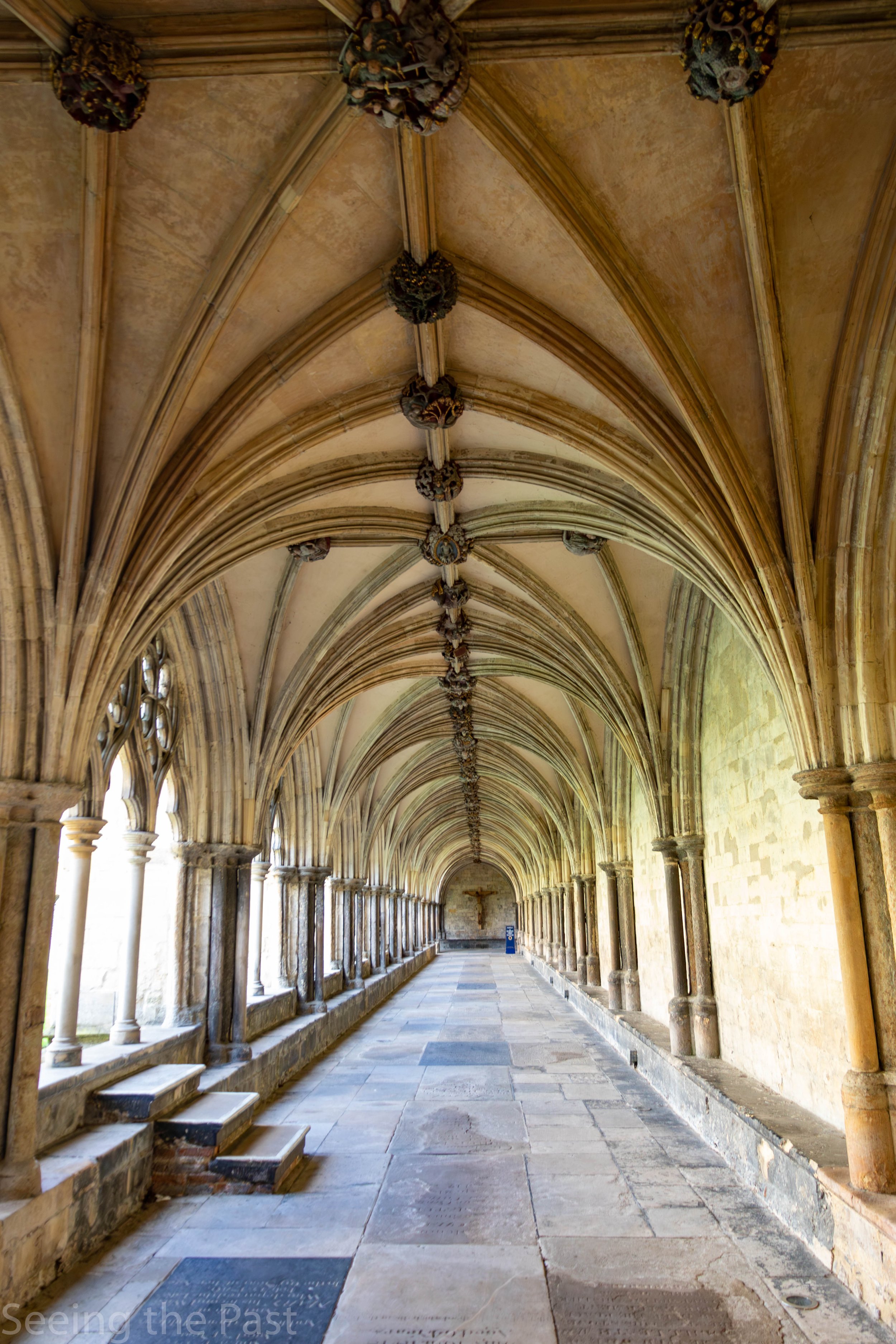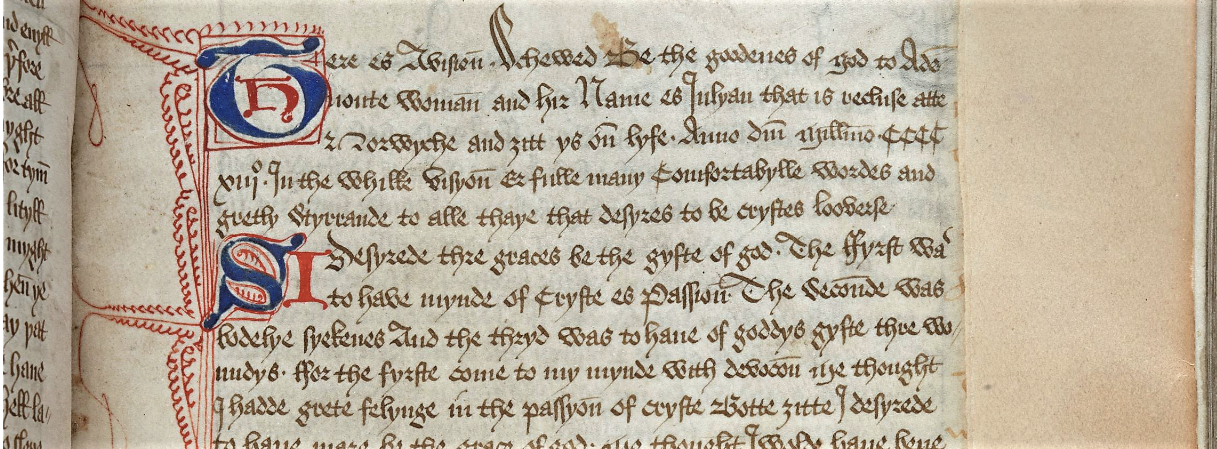The hidden secrets of Norwich Cathedral: one of the best examples of Romanesque architecture in Europe.
/Begun in 1096, Norwich Cathedral has become a wonderful example of Romanesque architecture with its huge semi circular Norman arches. Looking upwards reveals one of its amazing gems, the highly coloured 700 roof bosses telling the Biblical story from the “Creation” to the “Last Judgement” and greatly outnumbering all other cathedrals in the country. Norwich has the second largest cloisters in England but again looking up reveals more gems, this time, a brilliant collection of green men including the famous gold leaved one in the photo above. Looking down in the choir, on the other hand, gives you a chance to see some great misericords.
Menu
What is there to see at Norwich cathedral?
Above; the Ethelbert gate. This gate dates from 1320 but an earlier one has been dated to the 12th century.
Below; a close up showing the humorous gate decoration where a man with a small sword is about to take on a dragon!
Above; the Erpingham Gate dated 1420-35 and an early view of the west front of the Cathedral. Unfortunately, on the day we visited, it had a builder’s vehicle in front of it with some red fence panelling.
As you enter via the Erpingham Gate, on your left is the Carnary Chapel founded in 1316. Below this is an undercroft where bones were stored known as a “charnel house”. How did this come about you may ask? Due to a lack of space in churchyards, as new graves were dug, bones discovered from earlier graves were removed and placed in this consecrated building.
Above; your view if you enter the cathedral precinct from the Ethelbert gate in March.
Thanks to the new beta version of photoshop and AI, I was able to remove the lorry and red fence but they were replaced by a version of the middle door and not a copy of the door on the right. Thus, I apologise to everybody who notices the different doors to the right and left but I believe this is better and gentler on the eyes than the original lorry as seen in the first photo of the Erpingham gate. When I am next in the Norwich area, hopefully an accurate version can be taken without any encumbrances.
Above; on entering and turning left, the architecture stands out as early by the shape of the arches. Semi-circular arches are from the Norman period, the Romanesque style was used principally because they had not mastered gothic/pointed arches.
Above; in the centre and on the far right of this photo, two ribbed columns can be seen. These, plus two more which are out of sight, show where the original nave altar stood.
Above; as you wander up the nave, the beautiful Romanesque architecture continues, characterised by its semi-circular arches . At the top of the photo, the highest level, known as the clerestory, is a later addition because the arches for the stained glass windows are pointed and are termed gothic. Apparently, they were installed in the 14th century.
Looking from one side of the transept to the other.
Above; the West window, from the 15th century with stained glass dating from 1854.
Above; at the eastern end of the cathedral is St Saviour’s chapel.
Above; high up the vaulted ceiling can be seen with bosses joining the ribs and at the top of the photo, the wooden ceiling of the tower.
Above; one of those hidden secrets are the 700+ roof bosses and to help people see them without straining their necks, a large mirror is provided.
Above; the middle boss shows Noah building his ark.
Below; the great flood has come and Noah is afloat in his completed ark with his family and all the animals.
Above; my knowledge of the Bible is not good enough to accurately interpret these biblical scenes but they are rather beautiful. You can purchase a book giving you loads of photos of the bosses and a commentary.
Above; another treasure that you have to search for are the misericords. These are carvings on the bottom of a hinged seat that will give support to someone who has to stand with the seat is turned up, sometimes they can be funny and rather “naughty”. During long services, especially monastic ones, the choir and/or monks have to remain standing for up to three hours and so these flip up seats with shelves were invented to make them comfortable whilst appearing to stand up.
Below; a poor child is being whacked on the bottom probably for being naughty.
Below; misericords often feature weird animals and here is one being attacked by a brave soldier.
Above and below; I was also delighted to discover two green men to the load that I discovered in the cloisters (coming up). A “Green Man” is usually seen as a human head with vegetation coming out of him, surrounding him or, sometimes, covering him. No-one knows what he stands for but it has been suggested that he stands for fertility whilst others say he stands for the closeness of humans to nature. Further theories suggest that he symbolises the cycle of life, death and rebirth. He is possibly a pagan symbol that heralds the coming of Spring and lush vegetation growth, after a deciduous, dark, winter. This rebirth idea, links with Jesus rising from the dead on Easter Sunday. Some experts go on to say that, as most green men are now associated with churches, the Christian religion adopted and incorporated this symbol. Some have argued that it is a cross-over or linking symbol between pre-christian and christian religion.
The next treasure to see is series of paintings by Brian Whelan called, “The Passion of Edith Cavel: The way of the cross”. Information next to the paintings explains that Brian was influenced by the medieval tradition of East Anglian narrative painting and was inspired to tell the story of Edith Cavell.
Edith was born in Swardeston, near Norwich 1865 and initially worked as a governess in Brussels before coming back to England to nurse her sick father. When her father recovered, she decided to train in London as a nurse which resulted in her accepting a job in a hospital in Brussels. She was soon training nurses and is considered today, as the founder of modern nursing education in Belgium. After returning to England, World War One began and Edith felt it was her duty to return to Brussels immediately, despite it falling into German hands.
Edith in England. Courtesy of Imperial War Museum.
Her nursing school in Brussels soon became a hospital for casualties but Edith believed that she was called to treat men from both sides as well as civilian casualties. In September 1914, she treated two wounded British soldiers who had found themselves trapped behind the German lines at the Battle of Mons. When they were well enough, she went on to smuggle them out of the country to neutral Netherlands, with the help of local guides and some cash. Soon she became part of a network smuggling out British and French soldiers as well as Belgians who did not want to fight for the Germans. This was a very dangerous thing to do but inspired by her faith, Edith became a very brave woman.
Over the next eleven months her group was able to help 200 British and French troops escape to freedom along with some Belgians. However, the Germans had been suspicious of Edith’s activities for some time and on August 15th 1915, she was arrested, along with 34 others in her network. Edith immediately confessed at her trial and therefore she was sentenced to be executed by firing squad. Three days after her conviction she was executed and buried temporarily in Brussels. When the war ended, her body was exhumed and conveyed to England. After a funeral service at Westminster Abbey her coffin was taken to her final resting place, just outside Norwich Cathedral.
Above; World War One began and Edith goes back to Brussels to help nurse the wounded, no matter what side they had been on.
Above; the leaflet that goes with these paintings comments, “The kiss of betrayal is intimate and familiar,” linking the event to Judas kissing Jesus before he was arrested.
Above; Edith is executed 12th October 1915.
Above; an effigy from Saxon times which may well be St Felix who was the first bishop of the Kingdom of the East Angles when this country was divided into several kingdoms. He is credited as introducing Christianity to the East Angles and thereby freeing, “the whole kingdom from long-standing evil and unhappiness" according to the “Venerable Bede” in his Ecclesiastical History of the English People,
Norwich cathedral can boast that it has the second largest cloisters in England, only being beaten by those of Salisbury Cathedral
Above. Norwich also has the second highest spire, colossal 96 metres but again second to Salisbury Cathedral, checking out at 123 metres.
The cloisters are well worth seeing and time should be taken to look up at all the bosses in this section of the cathedral.
Above; this boss shows St George once again, killing a dragon.
Above; I believe this depicts the sealing of Jesus’ tomb.
Above; in my humble opinion, the pièce de résistance of the bosses in the cloisters is this green man. He is on the cover of books on the green man and is a great example to seek out.
Below; in the next four photos are four more green men to be discovered in the cloisters and a further two in the Ethelbert Gate.
Above; one last hidden treasure is the story of this lady who most people walk past without turning their heads to look at her. She is now known as Julian of Norwich and was an anchoress. She was born somewhere around the year 1343 AD and died sometime after 1416. An anchoress was a deeply devout woman who asked to be walled into a small cell to live the rest of her life in prayer and contemplation. Being in a cell would mean no distractions from her daily routines and a life of silence. The average cell was only 12 square feet, be attached to a church and had three windows. One would open out to a parlour where a servant would bring food and takeaway waste. Another would allow her to see the church and participate in Mass. The third window would allow her to see the outside world. Julia would be seen as an important member of the local community with her actions helping them to eventually get through to heaven. She would also be consulted for advice, something usually only done by the key males of the community but visitors would be limited.
Believe it or not, the extremely tough anchoritic life was popular with hundreds of ladies entering cells in the medieval period. There were one hundred anchoresses and anchorites (male) in the 12th century and this rose to two hundred, from the 13th to the 15th centuries. Furthermore, anchoresses always outnumbered anchorites and in the 13th century, there were three times as many anchoresses. When the anchoress’ cell became walled up, a priest would say the same set of prayers that he would say for someone’s funeral, symbolising they were dead to the world. Some would even be buried in their cell when they did die!
From the british library, part of the short text of Revelations of Divine Love (see below)
Julian is known to have written “Revelations of Divine Love” and in it she reveals several events in her life. In 1373 she nearly died with a curate administering the “last rites” thinking she was about to die. However, as he held a crucifix over the foot of her bed she saw the crucified Jesus bleed and over the next few hours, she had fifteen visions of Jesus, with one more the following day. She recovered and wrote it all down in what was known as her short text of the Revelations of Divine Love. Later on, she wrote a longer, more detailed version and tried to explore the meaning of each of her visions.
From the British library. the 1673 edition of of the long text of the revelations of divine love.
2. Some key moments in the history of the cathedral.
Construction of the cathedral began in 1096 with a core of flint and mortar which was faced with Caen stone. Norman philosophy was to consolidate and increase their power in England where they were seen foreign invaders. One aspect of this policy was to get rid of wooden Anglo-Saxon churches and cathedrals and replace them with larger stone ones. It seemed God was supporting the Normans. This is supported by the construction of dominating stone castles which added to the idea that the Normans were here to stay and should not be challenged. Norwich Cathedral was another impressive stone building to reinforce that message. The cathedral was completed in 1145 with the completion of the stone tower supporting a wooden spire. Construction also included a priory that existed until Henry VIII’s reformation and the “dissolution of the monasteries.”
In 1272, relations between the people of Norwich and the Norwich priory deteriorated over rights, duties and boundaries. Trouble had been brewing for a number of years and worsened in 1272 when some young men placed a quintain and practiced their jousting on disputed land. The prior’s men came out and attacked the jousters. Several young men were killed and at the coroner’s inquest, the prior’s men were found guilty. He ruled that if any of them came out into Norwich, they would be arrested. Two men did eventually come out and were arrested. The prior retorted by excommunicating the citizens of Norwich stating the inquest was a breach of his privileges. The priory became under siege with the prior’s men manning the walls and shooting arrows at passers by. Attempts to negotiate a truce failed and so the prior brought in three barge loads of armed men from Yarmouth.
A further disagreement, this time over taxes for a market, resulted in the cathedral being attacked and the gates of the priory and a nearby church, being set on fire. Many monastic buildings were destroyed and the the cathedral suffered serious damage. In the chaos, some monks were killed when trying to flee whilst the cathedral was plundered for three successive days. To re-establish law and order, Henry III sent in his representatives and then, personally supervised an investigation.When it was all over, HenryIII ordered the execution of 29 locals and the citizens of Norwich to pay for the repairs. They also had to send a representative to Rome to ask for the Pope’s forgiveness. On the cathedral’s side, Prior de Brougham was imprisoned with his bishop to decide his fate which was, needless to say, only light punishment. Several years later, the repairs were completed but the cloister was so severely damaged that it had to be replaced by a new cloister in 1297.
This wasn’t the end of the cathedral’s bad luck because the Norman spire was blown down in 1362 and in 1463 the spire was struck by lightning, which developed into a fire in the nave. In 1480, the bishop ordered a new spire to be built, this time out of brick and faced with stone. This is the spire we see today. In the 15th and early 16th centuries, the beautiful stone “tierceron vault” replaced the original flat wooden ceiling.
Below; the tierceron vault is where there are extra ribs put in for decorative value, see the T on the photo. It also has Lierne vaulting, where there are short decorative ribs,(L on the photo) that in total can form a star shape, although this example is a squashed star.
Essential Information
Getting there;
By car, there are several car parks nearby, including St Helen’s Wharf and Rose Lane.There are also Park and Ride services which bring people into the city centre by bus from various locations on the outskirts of Norwich. We recommend using the Park and Ride, easy to find, plenty of space and efficient.
By train, the Cathedral is a 10-minute stroll from Norwich Station via a riverside walk. Greater Anglia runs direct trains to Norwich from London, Cambridge and many places across East Anglia.
For current opening times and fees; click here.


























































A day’s wandering around this area of Coventry will present you with hundreds of years of history to discover. You will be able to visit the ruins of the 14th and 15th century church of St Michael that became a cathedral in 1918 as well as the new one next door.. About 160 metres away or a two minute walk, is Holy Trinity church with its amazing Medieval “Doom Painting” which some people believe is the best one in Britain. One minute away, is the wonderful and free Herbert Art Gallery and Museum.